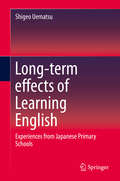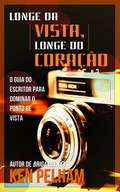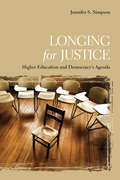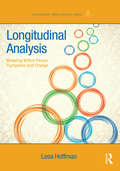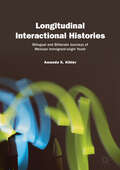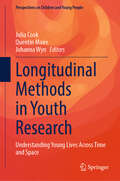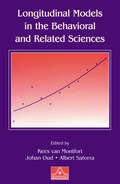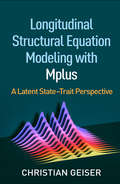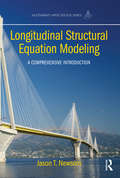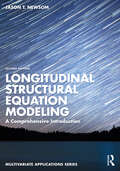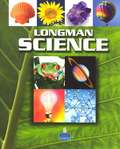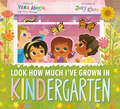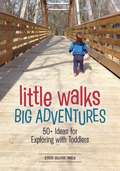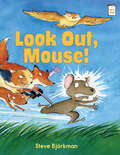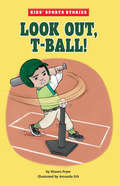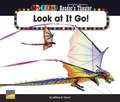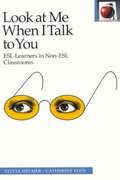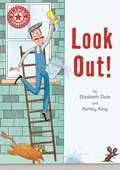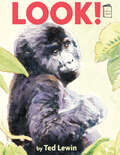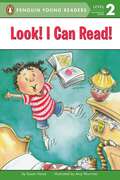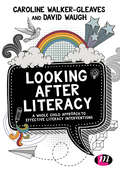- Table View
- List View
Long-term effects of Learning English
by Shigeo UematsuThis book presents a pioneering longitudinal study on English language instruction at the elementary school (ELES) level in the Japanese public school system. It attempts to identify those domains most sensitive to early English instruction by employing a state-of-the-art quantitative research methodology. English education was formally introduced in Japan for fifth and sixth graders in 2011 and is still in its infancy as a program. This study compares two groups (Grade 7 and 8) of students, one with ELES and one without, in order to shed light on their experiences. Comparisons are carried out not only quantitatively, measuring changes in English skills (listening, speaking, reading, and vocabulary / grammar) and the ELES students' affective aspects, but also qualitatively through in-depth interviews. Thus, this study attempts to capture the ELES students' experiences from a multi-dimensional perspective. The comprehensive literature review provided offers a valuable resource not only for researchers looking for a quick digest of the literature in this field before undertaking their own research, but also for policy-makers seeking to assess how to best implement ELES.
Longe da Vista, Longe do Coração: O Guia do Escritor para Dominar o Ponto de Vista
by João Romão Ken PelhamDescrição do livro: Como é que você põe de parte o filtro de escritor de ponto de vista e expressa o que uma personagem fictícia vê, ouve, pensa e experiencia? Como é que mantém o ponto de vista consistente? Como é que evita que o leitor deixe de estar sob o feitiço da sua narrativa e fique baralhado, dizendo "O quê? Espera aí..."? Uma das técnicas mais difíceis de compreender é a de saber escrever a partir da perspetiva das personagens fictícias. Longe da Vista, Longe do Coração é uma obra essencial, tanto para escritores de ficção, como de não ficção. Esta ensina, através de exemplos, a como detetar - e, mais importante, a como retificar - erros óbvios e não tão óbvios de ponto de vista narrativo.
Longing for Justice
by Jennifer S. SimpsonA timely and persuasive argument for Higher Education's obligations to our democratic society, Longing for Justice combines personal narrative with critical analysis to make the case for educational practices that connect to questions of democracy, justice, and the common good. Jennifer S. Simpson begins with three questions. First, what is the nature of the social contract that universities have with public life? Second, how might this social contract shape undergraduate education? And third, how do specific approaches to knowledge and undergraduate education inform how students understand society?In a bold challenge to conventional wisdom about Higher Education, Simpson argues that today's neoliberal educational norms foreground abstract concepts and leave the complications of real life, especially the intricacies of power, unexamined. Analysing modern teaching techniques, including service learning and civic engagement, Simpson concludes that for Higher Education to serve democracy it must strengthen students' abilities to critically analyse social issues, recognize and challenge social inequities, and pursue justice.
Longitudinal Analysis: Modeling Within-Person Fluctuation and Change (Multivariate Applications Series)
by Lesa HoffmanLongitudinal Analysis provides an accessible, application-oriented treatment of introductory and advanced linear models for within-person fluctuation and change. Organized by research design and data type, the text uses in-depth examples to provide a complete description of the model-building process. The core longitudinal models and their extensions are presented within a multilevel modeling framework, paying careful attention to the modeling concerns that are unique to longitudinal data. Written in a conversational style, the text provides verbal and visual interpretation of model equations to aid in their translation to empirical research results. Overviews and summaries, boldfaced key terms, and review questions will help readers synthesize the key concepts in each chapter. Written for non-mathematically-oriented readers, this text features: A description of the data manipulation steps required prior to model estimation so readers can more easily apply the steps to their own data An emphasis on how the terminology, interpretation, and estimation of familiar general linear models relates to those of more complex models for longitudinal data Integrated model comparisons, effect sizes, and statistical inference in each example to strengthen readers’ understanding of the overall model-building process Sample results sections for each example to provide useful templates for published reports Examples using both real and simulated data in the text, along with syntax and output for SPSS, SAS, STATA, and Mplus at www.PilesOfVariance.com to help readers apply the models to their own data The book opens with the building blocks of longitudinal analysis—general ideas, the general linear model for between-person analysis, and between- and within-person models for the variance and the options within repeated measures analysis of variance. Section 2 introduces unconditional longitudinal models including alternative covariance structure models to describe within-person fluctuation over time and random effects models for within-person change. Conditional longitudinal models are presented in section 3, including both time-invariant and time-varying predictors. Section 4 reviews advanced applications, including alternative metrics of time in accelerated longitudinal designs, three-level models for multiple dimensions of within-person time, the analysis of individuals in groups over time, and repeated measures designs not involving time. The book concludes with additional considerations and future directions, including an overview of sample size planning and other model extensions for non-normal outcomes and intensive longitudinal data. Class-tested at the University of Nebraska-Lincoln and in intensive summer workshops, this is an ideal text for graduate-level courses on longitudinal analysis or general multilevel modeling taught in psychology, human development and family studies, education, business, and other behavioral, social, and health sciences. The book’s accessible approach will also help those trying to learn on their own. Only familiarity with general linear models (regression, analysis of variance) is needed for this text.
Longitudinal Interactional Histories: Bilingual and Biliterate Journeys of Mexican Immigrant-origin Youth
by Amanda K. KiblerThis book explores the lives of five Mexican immigrant-origin youths in the United States, documenting their language and literacy journeys over an eight-year period from adolescence to young adulthood. In these qualitative case studies, the author uses a “longitudinal interactional histories approach” (LIHA) to explore literacy events in which the young people participated over time, telling the stories behind texts they created in order to better understand opportunities for bilingual and biliterate development available inside and outside of formal schooling. The book begins with an overview and exploration of theories and research underpinning the project, with a focus on countering minoritizing discourses faced by many multilingual immigrant youth and prioritizing the “goodness” of their experiences. The study’s methodology, including LIHA, is presented, before individual case studies of all five youth are explored. The book closes with a synthesis of these cases and exploration of pedagogical, policy, and research implications. It will be of particular interest to students and scholars of education, applied linguistics and sociolinguistics, as well as teachers and policy-makers working with bilingual and biliterate immigrant youth.
Longitudinal Methods in Youth Research: Understanding Young Lives Across Time and Space (Perspectives on Children and Young People #15)
by Johanna Wyn Julia Cook Quentin MaireThis book addresses how longitudinal research approaches are used to understand young people’s lives. It elucidates how youth researchers use longitudinal approaches, and how longitudinal research can help us to both understand and shape the field of youth sociology. Chapters discuss the creation of knowledge about youth and how longitudinal research shapes the field of youth sociology and shed light on key tensions and emerging debates in longitudinal youth research ranging from research design to data collection, analysis, and use. It considers longitudinal studies using a broad range of methods, including qualitative, quantitative, mixed methods, retrospective methods, and creative and participatory methods. This collection offers insights from longitudinal youth scholars conducting research in Argentina, Lithuania, Australia, Estonia, Canada, the United States (US), the United Kingdom (UK), Finland and India. These researchers reflect on the future of longitudinal youth research, addressing emerging and prospective issues. This book provides a concise survey of key established and emerging areas of concern in longitudinal research and of the relationship between these areas and the field of youth studies more specifically.
Longitudinal Models in the Behavioral and Related Sciences (European Association of Methodology Series)
by Kees Van MontfortThis volume reviews longitudinal models and analysis procedures for use in the behavioral and social sciences. Written by distinguished experts in the field, the book presents the most current approaches and theories, and the technical problems that may be encountered along the way. Readers will find new ideas about the use of longitudinal analysis in solving problems that arise due to the specific nature of the research design and the data available. Longitudinal Models in the Behavioral and Related Sciences opens with the latest theoretical developments. In particular, the book addresses situations that arise due to the categorical nature of the data, issues related to state space modeling, and potential problems that may arise from network analysis and/or growth-curve data. The focus of part two is on the application of longitudinal modeling in a variety of disciplines. The book features applications such as heterogeneity on the patterns of a firm’s profit, on house prices, and on delinquent behavior; non-linearity in growth in assessing cognitive aging; measurement error issues in longitudinal research; and distance association for the analysis of change. Part two clearly demonstrates the caution that should be taken when applying longitudinal modeling as well as in the interpretation of the results. This new volume is ideal for advanced students and researchers in psychology, sociology, education, economics, management, medicine, and neuroscience.
Longitudinal Structural Equation Modeling with Mplus: A Latent State-Trait Perspective (Methodology in the Social Sciences)
by Christian GeiserAn in-depth guide to executing longitudinal confirmatory factor analysis (CFA) and structural equation modeling (SEM) in Mplus, this book uses latent state–trait (LST) theory as a unifying conceptual framework, including the relevant coefficients of consistency, occasion specificity, and reliability. Following a standard format, chapters review the theoretical underpinnings, strengths, and limitations of the various models; present data examples; and demonstrate each model's application and interpretation in Mplus, with numerous screen shots and output excerpts. Coverage encompasses both traditional models (autoregressive, change score, and growth curve models) and LST models for analyzing single- and multiple-indicator data. The book discusses measurement equivalence testing, intensive longitudinal data modeling, and missing data handling, and provides strategies for model selection and reporting of results. User-friendly features include special-topic boxes, chapter summaries, and suggestions for further reading. The companion website features data sets, annotated syntax files, and output for all of the examples.
Longitudinal Structural Equation Modeling: A Comprehensive Introduction (Multivariate Applications Series)
by Jason T. NewsomThis comprehensive resource reviews structural equation modeling (SEM) strategies for longitudinal data to help readers see which modeling options are available for which hypotheses. The author demonstrates how SEM is related to other longitudinal data techniques throughout. By exploring connections between models, readers gain a better understanding of when to choose one analysis over another. The book explores basic models to sophisticated ones including the statistical and conceptual underpinnings that are the building blocks of the analyses.? Accessibly written, research examples from the behavioral and social sciences and results interpretations are provided throughout. The emphasis is on concepts and practical guidance for applied research rather than on mathematical proofs. New terms are highlighted and defined in the glossary. Figures are included for every model along with detailed discussions of model specification and implementation issues.? Each chapter also includes examples of each model type, comment sections that provide practical guidance, model extensions, and recommended readings. Highlights include: Covers the major SEM approaches to longitudinal analysis in one resource. Explores connections between longitudinal SEM models to enhance integration.? Numerous examples that help readers match research questions to appropriate analyses and interpret results. Reviews practical issues related to model specification and estimation to reinforce connections.? Analyzes continuous and discrete (binary and ordinal) variables throughout for breadth not found in other sources. Reviews key SEM concepts for those who need a refresher (Ch. 1).? Emphasizes how to apply and interpret each model through realistic data examples. Provides the book’s data sets at www.longitudinalsem.com along with the Mplus and R-lavaan syntax used to generate the results. Introduces the LISREL notation system used throughout (Appendix A).? The chapters can be read out of order but it is best to read chapters 1 – 4 first because most of the later chapters refer back to them. The book opens with a review of latent variables and analysis of binary and ordinal variables. Chapter 2 applies this information to assessing longitudinal measurement invariance.? SEM tests of dependent means and proportions over time points are explored in Chapter 3, and stability and change, difference scores, and lagged regression are covered in Chapter 4. The remaining chapters are each devoted to one major type of longitudinal SEM -- repeated measures analysis models, full cross-lagged panel models and simplex models, modeling stability with state-trait models, linear and nonlinear growth curve models, latent difference score models, latent transition analysis, time series analysis, survival analysis, and attrition. Missing data is discussed in the context of many of the preceding models in Chapter 13.? Ideal for graduate courses on longitudinal (data) analysis, advanced SEM, longitudinal SEM, and/or advanced data (quantitative) analysis taught in the behavioral, social, and health sciences, this text also appeals to researchers in these fields. Intended for those without an extensive math background, prerequisites include familiarity with basic SEM. Matrix algebra is avoided in all but a few places.
Longitudinal Structural Equation Modeling: A Comprehensive Introduction (Multivariate Applications Series)
by Jason T. NewsomLongitudinal Structural Equation Modeling is a comprehensive resource that reviews structural equation modeling (SEM) strategies for longitudinal data to help readers determine which modeling options are available for which hypotheses. This accessibly written book explores a range of models, from basic to sophisticated, including the statistical and conceptual underpinnings that are the building blocks of the analyses. By exploring connections between models, it demonstrates how SEM is related to other longitudinal data techniques and shows when to choose one analysis over another. Newsom emphasizes concepts and practical guidance for applied research rather than focusing on mathematical proofs, and new terms are highlighted and defined in the glossary. Figures are included for every model along with detailed discussions of model specification and implementation issues and each chapter also includes examples of each model type, descriptions of model extensions, comment sections that provide practical guidance, and recommended readings. Expanded with new and updated material, this edition includes many recent developments, a new chapter on growth mixture modeling, and new examples. Ideal for graduate courses on longitudinal (data) analysis, advanced SEM, longitudinal SEM, and/or advanced data (quantitative) analysis taught in the behavioral, social, and health sciences, this new edition will continue to appeal to researchers in these fields.
Longitudinal Studies of Creativity: A Special Issue of creativity Research Journal
by Mark A. RuncoSAME BLURB AS PART I--SEE RECORD #2838
Longman Geography class 8 - ICSE Board
by Anuradha Mukherjee & Rupasree MukherjeeLongman Geography for ICSE Classes 8, explores the physical as well as human aspects of our environment. It lays emphasis on the development of geographical skills and knowledge that students can utilize in their daily lives. The interactive approach of the series, supplemented with colourful and vivid photographs, tables and maps, facilitates a better understanding of the concepts. The in-text questions help the teachers to assess the level of understanding of the students.
Longman Science
by Pearson EducationLongman Science prepares students in grades 6-12 for success in a standards-based science program with a broad overview of life, earth, and physical science. All activities are specifically geared to students in the early stages of English language acquisition, and help build content knowledge, skills, and learning strategies. Special offer: Take advantage of our special offer: get the Longman Science Student Book and Workbook for only$44. 95. That's 25% off the regular price of these two books combined. Click here for details. Features For beginning to high beginning English language learners. "Getting Started" unit introduces concepts of science, safety, and the scientific method. Reading strategies are explicitly taught and modeled throughout the readings. Science skills, such as using and interpreting visuals, charts, and graphs are taught and recycled throughout each lesson. Unit Review provides additional practice, extension projects, further reading, and a Unit Experiment. Vocabulary building activities and glossaries help students access and build mastery of the content.
Look How Much I've Grown in KINDergarten (A KINDergarten Book)
by Vera AhiyyaWritten by the kindergarten teacher and Instagram influencer affectionately known as the Tutu Teacher, comes a KINDergarten story about celebrating all the amazing ways children grow-- inside and out-- throughout the year.Spring has sprung in KINDergarten! Flowers grow just outside the classroom. The trees are budding, and even baby birds begin to chirp, but Mason isn&’t feeling very cheerful. Mason sees her friends getting better at everything, but she doesn&’t think she can do anything right. But Mason's favorite teacher Ms. Perry has an idea... a growth chart! It&’s not like other growth charts that measure how tall children grow, it&’s a place for students to put how they each want to change and grow over the next few months. Sure, some students want to get taller, but others have different goals. Reynaldo wants to learn the sound of every letter in the alphabet, Irene wants to learn how to ride a bike without training wheels, and Mason, well Mason wants to grow in every way!This reassuring story told by Vera Ahiyya and brought to life by Joey Chou's exuberant illustrations will help every young reader feel more comfortable in kindergarten by reminding them that we all shine in different ways. And as kind Ms. Perry says, &“It is always ok to ask for help. Seeds don&’t grow all on their own. They need the help of the sun, good soil and water to grow—— just like you!&”
Look Inside! Little Walks, Big Adventures: 50+ Ideas for Exploring with Toddlers
by Erin BuhrWhile most activity books encourage indoor explorations, countless adventures and learning opportunities await outside! Going for a walk or exploring the local community can bring about much more than just exercise. Little Walks, Big Adventures helps you teach your toddler about his/her surroundings through fun and adventurous local explorations, outdoor games and activities that promote and enhance learning. Parents and caregivers will help their toddlers enhance their: Vocabulary Language skills Cognitive skills Motor Skills And more!
Look Out! (Reach Into Phonics Ser.)
by Deborah J. Short Joanna Korba Willa JimmersonNIMAC-sourced textbook
Look Out, Mouse! (I Like to Read)
by Steve BjörkmanThe chickens are enjoying their feed, the dog is eagerly emptying his bowl—but Farmer Fred forgot to feed the horse. But Mouse will help, in this Guided Reading Level E story! Mouse nibbles at the bag of oats so Horse can get his dinner, too—until Cat chases him away. Look out, Mouse! Cat is soon joined by Owl and Snake, and Mouse has nowhere to run. . . . until grateful Horse starts a noisy riot that gets Farmer Fred to open the door. Look out, house! It's time for Mouse's dinner. Perfect for kindergarten and early first grade students to read on their own, Look Out, Mouse! features a simple text with lots of repetition and patterns, supported by Steve Bjorkman's lively, detailed illustrations. This farm is full of laughs—and a reminder that sometimes, lending someone a hand will help you both in the end. The award-winning I Like to Read® series focuses on guided reading levels A through G, based upon Fountas and Pinnell standards. Acclaimed author-illustrators--including winners of Caldecott, Theodor Seuss Geisel, and Coretta Scott King honors—create original, high quality illustrations that support comprehension of simple text and are fun for kids to read with parents, teachers, or on their own! Level E stories feature a distinct beginning, middle, and end, with kid-friendly illustrations offering clues for more challenging sentences. Varied punctuation and simple contractions may be included. Level E books are suitable for early first graders. When Level E is mastered, follow up with Level F.
Look Out, T-Ball! (Kids' Sports Stories)
by Shawn PryorMarlon knows he's not the best player on his T-ball team, but he can't understand why he's striking out at the sport, especially when he tries so hard. Teammate Anna offers to practice with him and soon sees why Marlon can't focus.
Look at Me When I Talk to You: ESL Learners in Non-ESL Classrooms (2nd edition)
by Sylvia Helmer Catherine L. EddyThis book explores the underlying fundamentals of communication to show how culture influences the messages sent and received. Elements of both the theory and practice of communicating in a multicultural setting are discussed, and examples from real classrooms illustrate the issues that can, and do, arise. Practical suggestions provided in this book help all teachers working with students who are learning English as an additional language.
Look out!: Independent Reading Red 2 (Reading Champion #94)
by Elizabeth DaleIn this story, Ted is up his ladder cleaning windows when a mouse scampers past, followed by a cat, followed by a dog, followed by a boy - uh oh, look out Ted!Reading Champion is a book banded reading programme for independent reading offering fantastic, original stories accompanied by engaging artwork. Each book has been carefully levelled making it easy to match to a child's reading ability and fully supports reading for pleasure.
Look! (I Like to Read)
by Ted LewinLook! An elephant eats. Look! Giraffes drink. Look! A warthog digs. A gorilla hides, wild dogs listen, zebras run, monkeys sit, hippos splash, and a rhino naps. Each line of text is illustrated by a two-page spread with a beautiful painting of an animal Ted Lewin has seen on his journeys to Africa. At the end of the story, a boy reads, plays, and dreams, surrounded by toy animals that represent each of the real ones. This book encourages children to observe, enjoy, and appreciate the natural world. Guided Reading Level D.
Look! I Can Read! (Penguin Young Readers, Level 2)
by Susan HoodA little girl proudly shows off her reading skills as she spends a day out on the town with her mom. Children are sure to be delighted as they read along with the narrator in ths fun, rhyming, easy-to-read story.
Looking After Literacy: A Whole Child Approach to Effective Literacy Interventions
by David Waugh Caroline Walker-GleavesThis book is about supporting all children to overcome their individual challenges to literacy. It is about considering the whole child when exploring options for interventions and accepting that many children have more than one need. It examines the many factors that can contribute to literacy difficulties and highlights the importance of understanding the wider context when considering them. The text draws on the latest research in education, psychology , neurology and sociology to illustrate how children's literacy development can be mapped against difficulties in other areas of their lives. This is a ground-breaking and accessible book for all trainee and existing primary teachers working with young children who are experiencing difficulty with reading, written and spoken language.
Looking After Literacy: A Whole Child Approach to Effective Literacy Interventions
by David Waugh Caroline Walker-GleavesThis book is about supporting all children to overcome their individual challenges to literacy. It is about considering the whole child when exploring options for interventions and accepting that many children have more than one need. It examines the many factors that can contribute to literacy difficulties and highlights the importance of understanding the wider context when considering them. The text draws on the latest research in education, psychology , neurology and sociology to illustrate how children′s literacy development can be mapped against difficulties in other areas of their lives. This is a ground-breaking and accessible book for all trainee and existing primary teachers working with young children who are experiencing difficulty with reading, written and spoken language.
